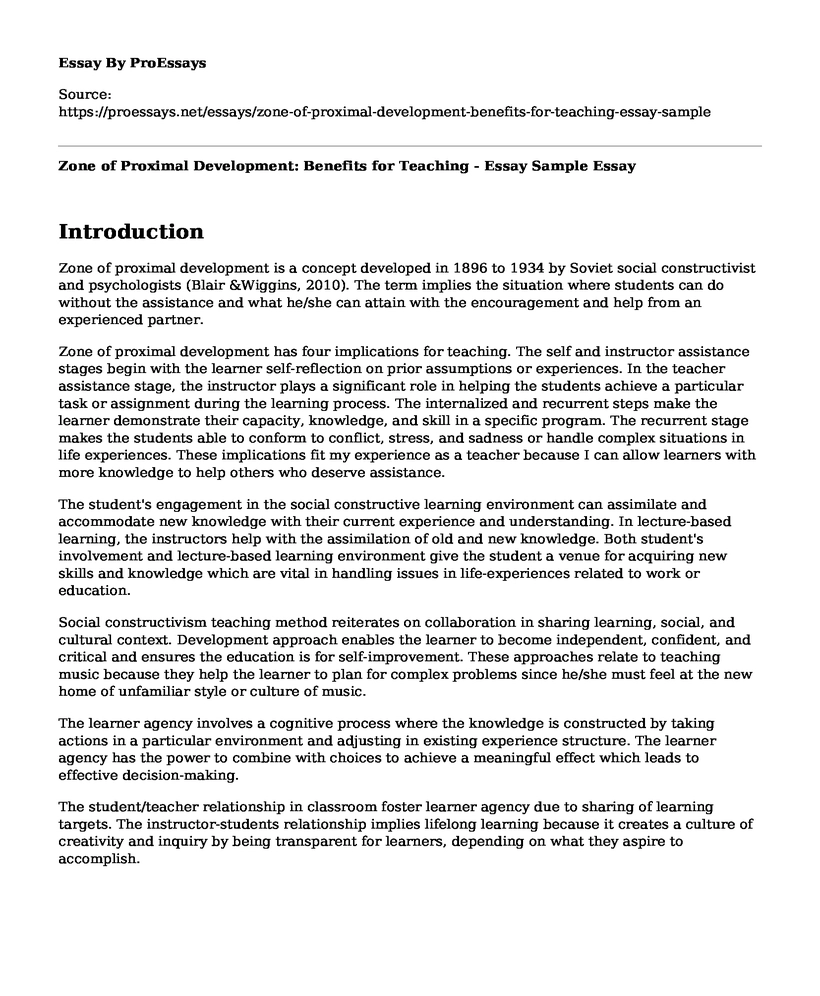Introduction
Zone of proximal development is a concept developed in 1896 to 1934 by Soviet social constructivist and psychologists (Blair &Wiggins, 2010). The term implies the situation where students can do without the assistance and what he/she can attain with the encouragement and help from an experienced partner.
Zone of proximal development has four implications for teaching. The self and instructor assistance stages begin with the learner self-reflection on prior assumptions or experiences. In the teacher assistance stage, the instructor plays a significant role in helping the students achieve a particular task or assignment during the learning process. The internalized and recurrent steps make the learner demonstrate their capacity, knowledge, and skill in a specific program. The recurrent stage makes the students able to conform to conflict, stress, and sadness or handle complex situations in life experiences. These implications fit my experience as a teacher because I can allow learners with more knowledge to help others who deserve assistance.
The student's engagement in the social constructive learning environment can assimilate and accommodate new knowledge with their current experience and understanding. In lecture-based learning, the instructors help with the assimilation of old and new knowledge. Both student's involvement and lecture-based learning environment give the student a venue for acquiring new skills and knowledge which are vital in handling issues in life-experiences related to work or education.
Social constructivism teaching method reiterates on collaboration in sharing learning, social, and cultural context. Development approach enables the learner to become independent, confident, and critical and ensures the education is for self-improvement. These approaches relate to teaching music because they help the learner to plan for complex problems since he/she must feel at the new home of unfamiliar style or culture of music.
The learner agency involves a cognitive process where the knowledge is constructed by taking actions in a particular environment and adjusting in existing experience structure. The learner agency has the power to combine with choices to achieve a meaningful effect which leads to effective decision-making.
The student/teacher relationship in classroom foster learner agency due to sharing of learning targets. The instructor-students relationship implies lifelong learning because it creates a culture of creativity and inquiry by being transparent for learners, depending on what they aspire to accomplish.
Culturally Relevant Pedagogy in Music
Choral
Gloria Billings-Ladson prescribes the three tenants for culturally pedagogy such conceptions for knowledge, conception for self and others and response to diversity via instructional delivery (Ladson-Billings, 1995).
The most teaching strategy is connecting the real-world problem in a culturally responsive classroom to allow the learners to handle issues using their diverse experience. The moderate approach is using different technology forms like movies, books, tablets, and computers to help learners of different cultures learn on how to address their needs. Lastly, the least teaching strategy is incorporating culturally responsive languages to accommodate all learners irrespective of their societies or communities.
General Music
Culturally relevance pedagogy, according to Abril, entails the ability of a teacher to prepare meaningful materials and utilize them for effective teaching strategies that build the connection between school and home for students (Abril, 2013). According to Bond, CRP does not motivate people to acquire competitive advantage but enhance the peer-learning where any learner can be a teacher (Blair &Wiggins, 2010).
The most strategy I am comfortable for using is conception for others and self. CRP believes that all learners can achieve academically and see themselves as a member of society and struggle to give back to the community. The last strategy I am comfortable using is structure in social relation since CRP promote only pear-learning where any person can be a teacher.
References
Abril, C. R. (2013). Toward a more culturally responsive general music classroom. General Music Today, 27(1), 6-11. https://doi.org/10.1177/1048371313478946
Blair, D.V., &Wiggins, J. (2010). Teaching for musical understanding. A constructivist approach. In J. Ballantyne &B. Bartleet (Eds), Navigating music and sound education (pp. 16-30). Newcastle upon Tyne, UK: Cambridge Scholars
Ladson-Billings, G. (1995). Toward a theory of culturally relevant pedagogy. American Education Research Journal, 33(3), 465-491. https://doi.org/10.3102/00028312032003465
Cite this page
Zone of Proximal Development: Benefits for Teaching - Essay Sample. (2023, Feb 17). Retrieved from https://proessays.net/essays/zone-of-proximal-development-benefits-for-teaching-essay-sample
If you are the original author of this essay and no longer wish to have it published on the ProEssays website, please click below to request its removal:
- Request for Reinstatement of Physical Education in School
- Woody Allen's Bibliography
- BBC Documentary on Iran and the West Paper Example
- Poetry and Graphic Design Essay
- Essay Sample on Internet Censorship in China: Government Capacity Tested
- Eviction, Racism, & Inequality: An American Crisis - Essay Sample
- Essay Example on Literacy: A Lifetime Learning Process Essential to Education







